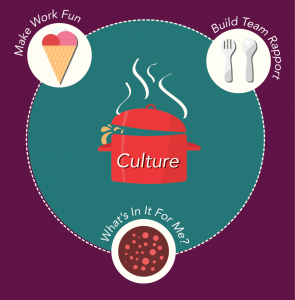![]()

Have you ever had a job where you loved showing up to work every day? You know, the kind of job where the work was worth doing? The type of place where you like the people you worked with and could depend on them for anything? The truth is, it all comes down to culture. When great people enjoy what they do, and they enjoy who they work with, productivity soars. But the opposite situation can be excruciating for even the most highly motivated people.

Build Team Rapport
When someone becomes your friend, it is a lot harder to let them down. When teams work together to reach goals, they are more likely to make up ground for individual weaknesses by helping each other to succeed. Let’s look at rapport in the context of sports. If you have ever played a team sport, you know just how different it is from individual sports.
When you work as an individual, everything is on your shoulders for success or failure. Your weaknesses are visible, and to become an elite athlete takes hours and hours of practice every day. Commitment to the ultimate goal becomes your sole focus in all aspects of your life.
But team sports are vastly different. Even if players have weaknesses, there are always ways to integrate them into the game so that they can be successful. A great coach knows how to exploit the strengths of every member of the team to have a winning season. We still need to work on our skills and overcome weaknesses, but a team will allow elite athletes to shine while still providing an opportunity to contribute to other less talented members of the team. And the support and commitment of the team override the individual ambitions and motivations. We want to win for the team.
Rapport is such an essential contribution to enjoying the work environment. If we like the people we work with, we are more likely to collaborate across functional silos, take the time to explain something to someone, and transfer our knowledge to help others develop technical skills. If we don’t enjoy the people we work with, the opposite is true: we don’t collaborate, we don’t work together, and we don’t easily exchange ideas.
If our staff is constantly overworked, doing more with less and they are left with very little time to build rapport among the team. A manager must build team building into all activities. For example, instead of traditional classroom-type training where attendees sit and listen all day to mind-numbing information and retain very little at the end of the day, build a curriculum that forces people to work and be successful as teams. Instead of handing our work to individuals to accomplish, establish small work teams, or pair up team members to work on projects together. Be clear that to be successful, the team needs to figure out how to work on the project as a team with every member working to contribute to the success of the outcome.
And don’t forget the team-building exercises where small teams compete to accomplish goals or the entire team works together to solve problems. Team building exercises provide time away from work to relax our minds from the day-to-day challenges we face but also provide ample time to get to know others in the work environment on a more personal level. A well-designed activity can also work to improve specific challenges in the work environment that are observed by the manager.
And if you are a manager who is working with a poisoned apple – a person who is single-handedly creating an environment where no one wants to work – you must either remove that person or channel their energies somewhere else. Rapport is the number one ingredient because without it, changing the culture in the environment is nearly impossible.

Make Work Fun
While there are many ideas in books and blog articles on how to make work fun, enjoying your work is a lot more complicated than simply buying a ping pong table and having a game room to relax. Work is enjoyable when you like who you work with (see ingredient #1), you like who you work for, there is an acceptable level of challenge and autonomy, and the work is worth doing. If you can create work that is worth doing, people commit to a cause so much more easily than they do to the mundane and boring.
Think back through your career and identify when you were the happiest at work. Likely you remember the people you worked for, an engaging project, or an opportunity to do something new and exciting. If you are fortunate, you had all of those things in the environment. It is probably not easy to change the people you work with to make things fun again. There are many recommendations on temporary fixes to make work fun. While you may be able to create a momentary emotional lifting environment, culture is much deeper than that and not easily influenced by simple fixes.
Instead, focus on a simple rule: eliminate two negatives, and implement one positive. In almost every environment, there is usually a person – manager or team member – that is creating a negative feeling in the environment. While it may not always be possible to let go of an employee, especially if they have tenure – but moving that individual into a new role away from the current environment can be a win for everyone. You can provide a unique opportunity for the individual, and you eliminate a negative force in the work environment.
The second negative is to survey the team and find out what company policies or work circumstances are not working for the group as a whole. Use the survey results to identify one negative part of everyday work life, and it could be a significant lift in an employee’s general feelings about the work environment. While eliminating two negatives may seem to be a lot of change, it will not be enough to change the culture and make it fun to work in the environment.
It is important to also focus on the positive. Find one idea – something that can create some excitement and enthusiasm in the environment – and develop a plan to implement one positive change. The possibilities are endless. You could change work schedules, implement a coaching program, invest in training, any positive change that shows your team that things are going to be different.
The formula of eliminating two negatives and implement one positive will be the catalyst for positive change in the environment. While it can’t completely change the situation, it will show the team that things will be different and that you are invested in the long-term success of the team. Creating enthusiasm in the work environment is about eliminating the negatives while also focusing on creating positive changes.

WIIFM
Remember that employees enjoy working for companies where there is job security, an acceptable level of challenge, but also an investment in the individual. Not all employees are looking to become team leaders, advance in the work environment, and increase their level of responsibility. Take time to get to know all the members of your team. Remember their birthdays, special events, kid’s names, significant others, pets….the people that influence your team members outside of the work environment. The significant influencers are essential to your staff; if you value them as well – it will go a long way to showing how much you care about the individual. Keep a calendar of important dates from the past and future – and develop simple ways to acknowledge key life milestones. A card on birthdays, a thank you after a big project, a dog treat for a favorite pet – small individual celebrations are just as important as the big team celebrations.
It is equally important to understand personal influencers in the work environment. Each team member is likely to be motivated by different factors. Take the time to develop a personal plan with each of your team members – a development roadmap where the employee receives learning and growth opportunities. Remember, personalization is the key. If a team member just had a new addition to the family – it may not be the right time to send them off to training or assign a new project. Instead, an opportunity for time off or a shift in schedule may be more important.
Development opportunities are more than just training or fascinating projects. You can offer opportunities to work with other staff members, other teams, start a charitable organization or fundraiser, plan a team-building exercise, or tackle a workplace problem. The opportunities are endless if you are creative, use your imagination, and work with each team member individually to find out what is important to them. If you find team members that have similar goals, offer to have them work as a team. Fostering collaboration can help to develop a more positive work environment and create lasting friendships in the workplace and beyond. Remember, if team members care as much about each other as they do about themselves (see ingredient #1) – they will help each other to achieve personal goals.

Stir, Bake, and Enjoy
As a manager or team lead, focus on the three most essential ingredients of great work culture: building team rapport, make work fun, and WIIFM. But remember, if you don’t enjoy the work environment, it is doubtful that you will create an environment for others to thrive. Be sure to develop your plan, work with your boss to eliminate two negatives, and implement one positive in your role as a manager.
With the right ingredients, you will have the beginnings of a work environment where your staff is happy to come to work. But remember that a good culture doesn’t thrive on its own. Commitment on your part and also the commitment of your team will ensure that the culture continues to evolve into a work environment where everyone can be proud and enjoy working again.



